Business Environment Analysis and Report: M&S Company Project
VerifiedAdded on 2020/10/23
|15
|4951
|99
Report
AI Summary
This report provides a detailed analysis of the business environment, focusing on Marks & Spencer (M&S). It begins with an introduction to the concept of the business environment, encompassing both internal and external factors influencing an organization's operations. The report then delves into the different types and purposes of organizations, including private, public, and voluntary sectors, using M&S as a key example of a private sector entity. It also examines the size and scope of various organizations, comparing M&S with the NHS and Oxfam. The core of the report explores the relationships between different organizational functions, such as production, marketing, operations, human resources, and finance, and how they contribute to achieving organizational objectives and structure. Furthermore, it applies the PESTLE model to assess the macro-environment's impact on M&S and conducts internal and external analyses using SWOT analysis. The report also discusses the interrelation of strengths and weaknesses with external macro factors, concluding with an assessment of the overall business environment of M&S and its strategic implications.
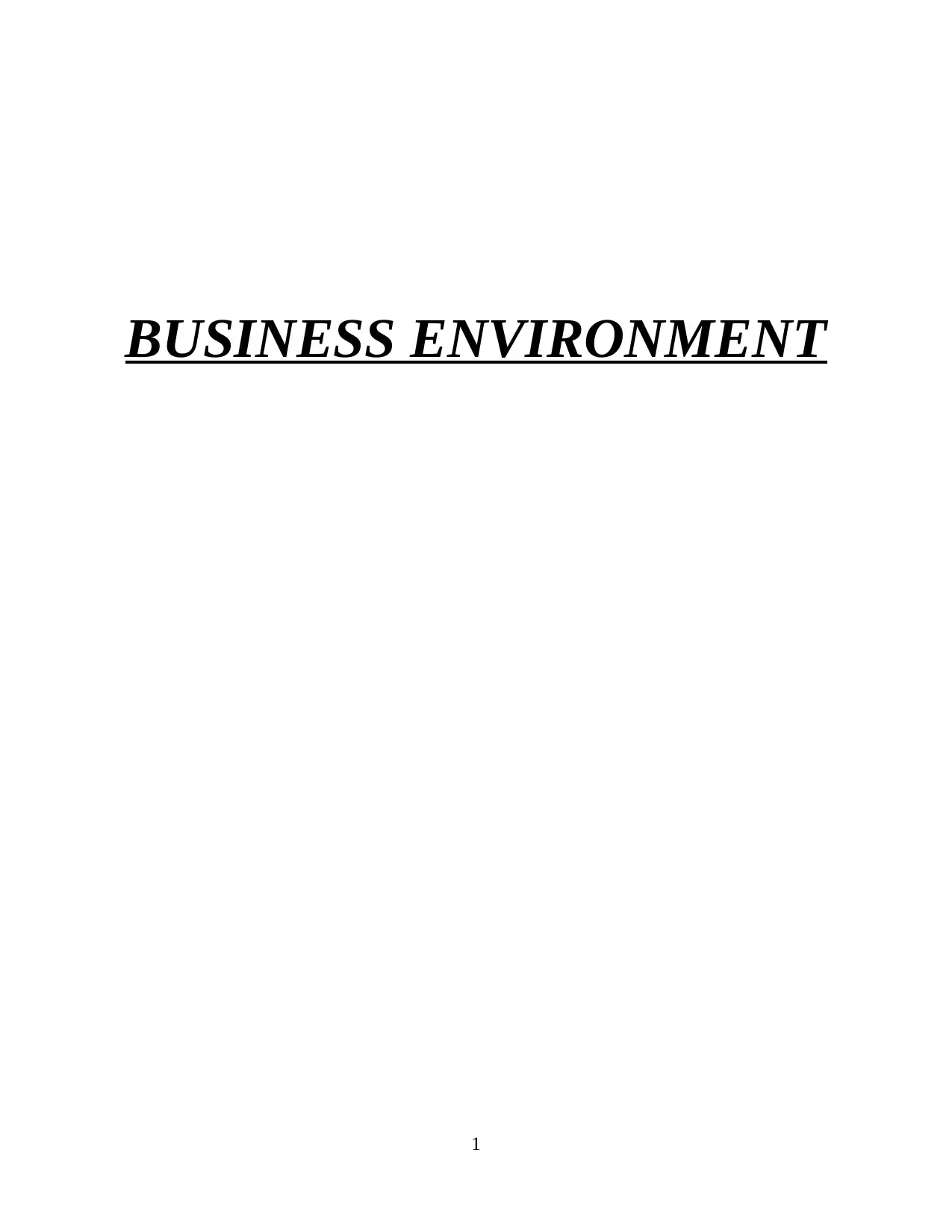
BUSINESS ENVIRONMENT
1
1
Paraphrase This Document
Need a fresh take? Get an instant paraphrase of this document with our AI Paraphraser
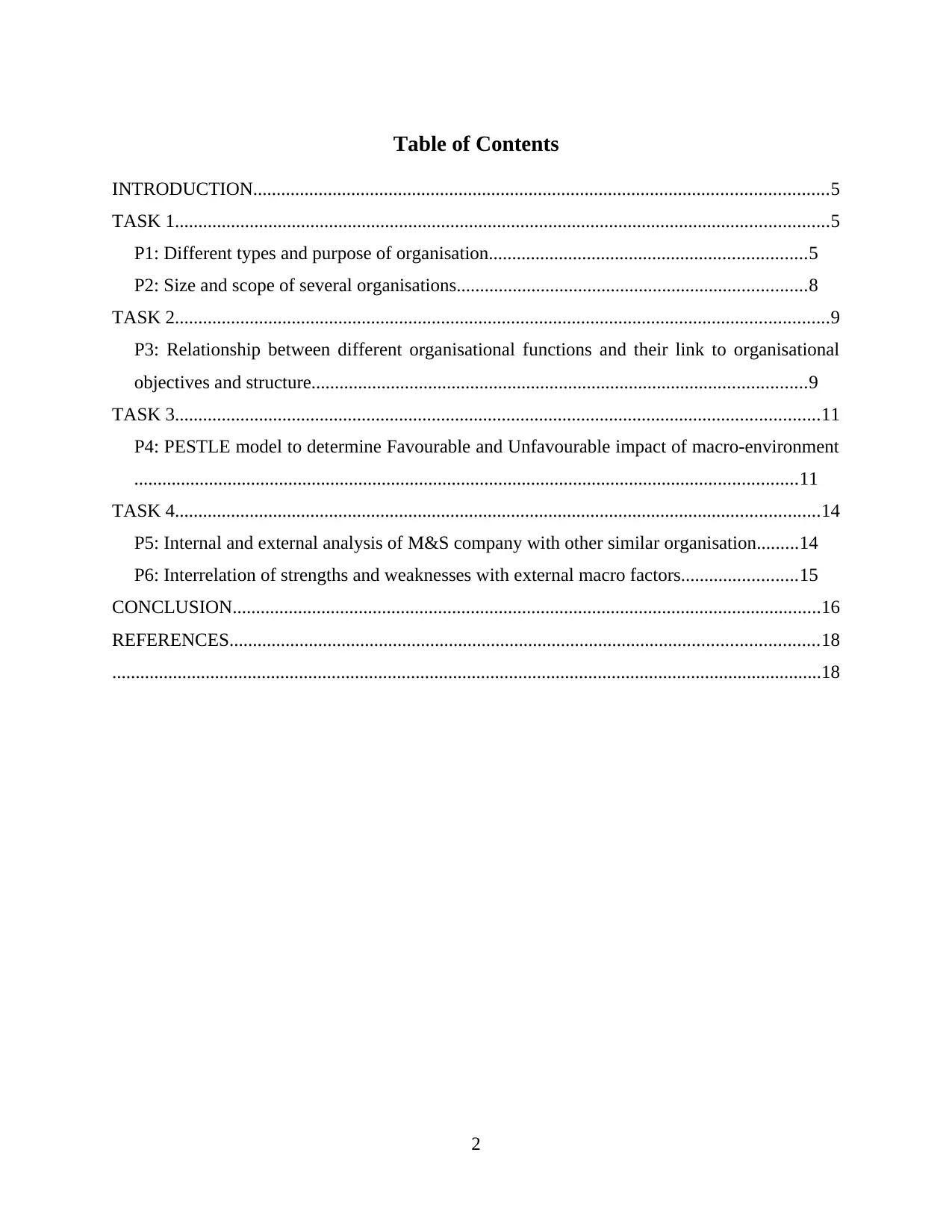
Table of Contents
INTRODUCTION...........................................................................................................................5
TASK 1............................................................................................................................................5
P1: Different types and purpose of organisation....................................................................5
P2: Size and scope of several organisations...........................................................................8
TASK 2............................................................................................................................................9
P3: Relationship between different organisational functions and their link to organisational
objectives and structure..........................................................................................................9
TASK 3..........................................................................................................................................11
P4: PESTLE model to determine Favourable and Unfavourable impact of macro-environment
..............................................................................................................................................11
TASK 4..........................................................................................................................................14
P5: Internal and external analysis of M&S company with other similar organisation.........14
P6: Interrelation of strengths and weaknesses with external macro factors.........................15
CONCLUSION..............................................................................................................................16
REFERENCES..............................................................................................................................18
........................................................................................................................................................18
2
INTRODUCTION...........................................................................................................................5
TASK 1............................................................................................................................................5
P1: Different types and purpose of organisation....................................................................5
P2: Size and scope of several organisations...........................................................................8
TASK 2............................................................................................................................................9
P3: Relationship between different organisational functions and their link to organisational
objectives and structure..........................................................................................................9
TASK 3..........................................................................................................................................11
P4: PESTLE model to determine Favourable and Unfavourable impact of macro-environment
..............................................................................................................................................11
TASK 4..........................................................................................................................................14
P5: Internal and external analysis of M&S company with other similar organisation.........14
P6: Interrelation of strengths and weaknesses with external macro factors.........................15
CONCLUSION..............................................................................................................................16
REFERENCES..............................................................................................................................18
........................................................................................................................................................18
2
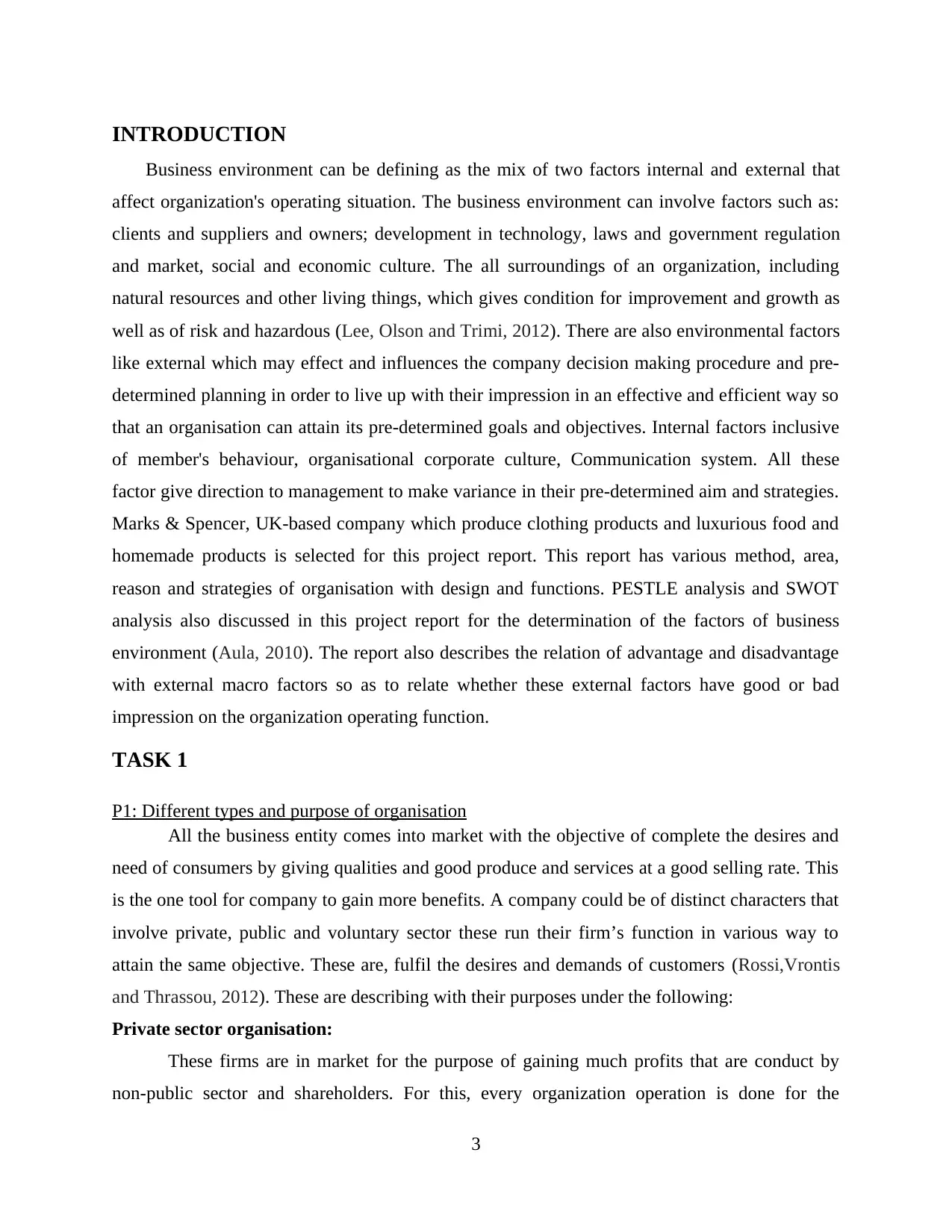
INTRODUCTION
Business environment can be defining as the mix of two factors internal and external that
affect organization's operating situation. The business environment can involve factors such as:
clients and suppliers and owners; development in technology, laws and government regulation
and market, social and economic culture. The all surroundings of an organization, including
natural resources and other living things, which gives condition for improvement and growth as
well as of risk and hazardous (Lee, Olson and Trimi, 2012). There are also environmental factors
like external which may effect and influences the company decision making procedure and pre-
determined planning in order to live up with their impression in an effective and efficient way so
that an organisation can attain its pre-determined goals and objectives. Internal factors inclusive
of member's behaviour, organisational corporate culture, Communication system. All these
factor give direction to management to make variance in their pre-determined aim and strategies.
Marks & Spencer, UK-based company which produce clothing products and luxurious food and
homemade products is selected for this project report. This report has various method, area,
reason and strategies of organisation with design and functions. PESTLE analysis and SWOT
analysis also discussed in this project report for the determination of the factors of business
environment (Aula, 2010). The report also describes the relation of advantage and disadvantage
with external macro factors so as to relate whether these external factors have good or bad
impression on the organization operating function.
TASK 1
P1: Different types and purpose of organisation
All the business entity comes into market with the objective of complete the desires and
need of consumers by giving qualities and good produce and services at a good selling rate. This
is the one tool for company to gain more benefits. A company could be of distinct characters that
involve private, public and voluntary sector these run their firm’s function in various way to
attain the same objective. These are, fulfil the desires and demands of customers (Rossi,Vrontis
and Thrassou, 2012). These are describing with their purposes under the following:
Private sector organisation:
These firms are in market for the purpose of gaining much profits that are conduct by
non-public sector and shareholders. For this, every organization operation is done for the
3
Business environment can be defining as the mix of two factors internal and external that
affect organization's operating situation. The business environment can involve factors such as:
clients and suppliers and owners; development in technology, laws and government regulation
and market, social and economic culture. The all surroundings of an organization, including
natural resources and other living things, which gives condition for improvement and growth as
well as of risk and hazardous (Lee, Olson and Trimi, 2012). There are also environmental factors
like external which may effect and influences the company decision making procedure and pre-
determined planning in order to live up with their impression in an effective and efficient way so
that an organisation can attain its pre-determined goals and objectives. Internal factors inclusive
of member's behaviour, organisational corporate culture, Communication system. All these
factor give direction to management to make variance in their pre-determined aim and strategies.
Marks & Spencer, UK-based company which produce clothing products and luxurious food and
homemade products is selected for this project report. This report has various method, area,
reason and strategies of organisation with design and functions. PESTLE analysis and SWOT
analysis also discussed in this project report for the determination of the factors of business
environment (Aula, 2010). The report also describes the relation of advantage and disadvantage
with external macro factors so as to relate whether these external factors have good or bad
impression on the organization operating function.
TASK 1
P1: Different types and purpose of organisation
All the business entity comes into market with the objective of complete the desires and
need of consumers by giving qualities and good produce and services at a good selling rate. This
is the one tool for company to gain more benefits. A company could be of distinct characters that
involve private, public and voluntary sector these run their firm’s function in various way to
attain the same objective. These are, fulfil the desires and demands of customers (Rossi,Vrontis
and Thrassou, 2012). These are describing with their purposes under the following:
Private sector organisation:
These firms are in market for the purpose of gaining much profits that are conduct by
non-public sector and shareholders. For this, every organization operation is done for the
3
⊘ This is a preview!⊘
Do you want full access?
Subscribe today to unlock all pages.

Trusted by 1+ million students worldwide
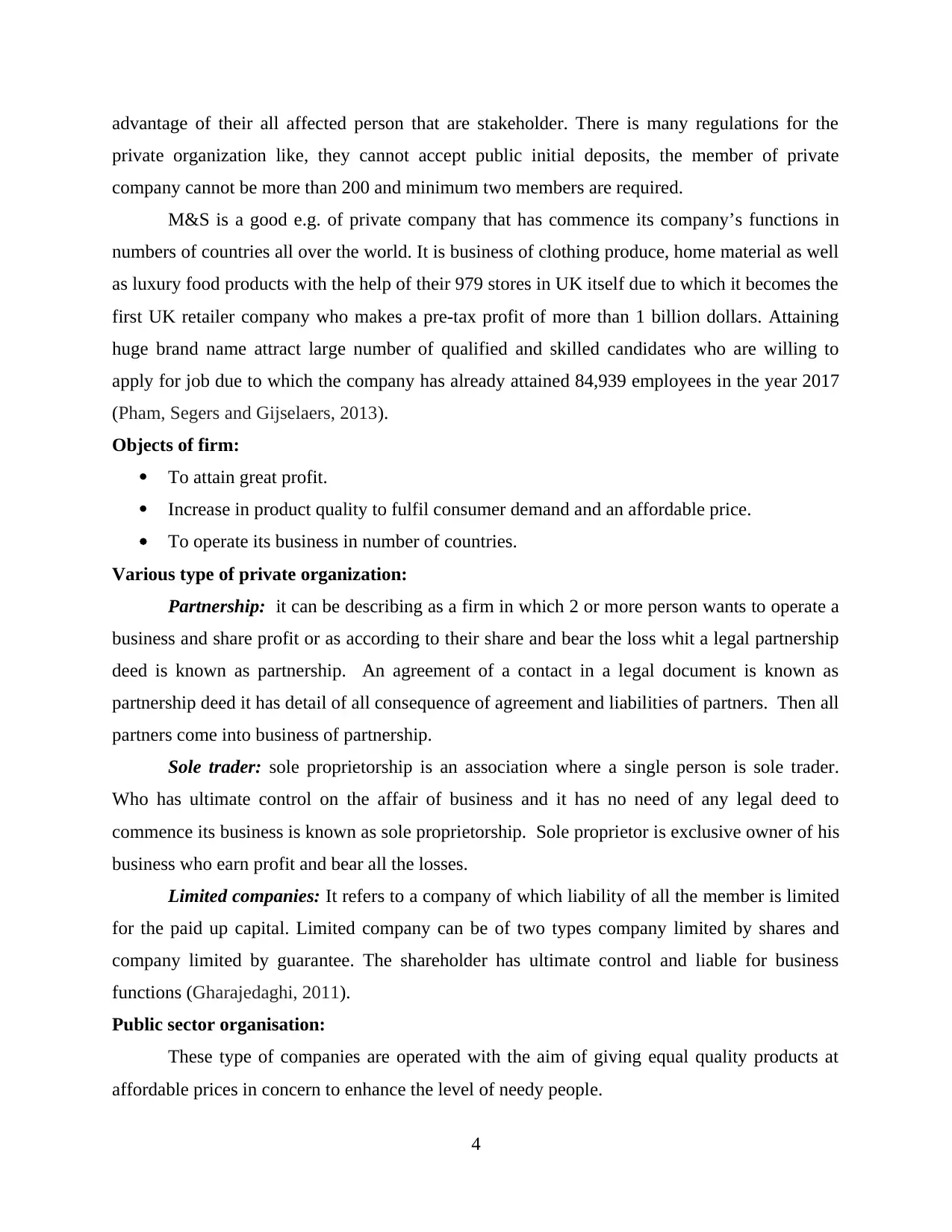
advantage of their all affected person that are stakeholder. There is many regulations for the
private organization like, they cannot accept public initial deposits, the member of private
company cannot be more than 200 and minimum two members are required.
M&S is a good e.g. of private company that has commence its company’s functions in
numbers of countries all over the world. It is business of clothing produce, home material as well
as luxury food products with the help of their 979 stores in UK itself due to which it becomes the
first UK retailer company who makes a pre-tax profit of more than 1 billion dollars. Attaining
huge brand name attract large number of qualified and skilled candidates who are willing to
apply for job due to which the company has already attained 84,939 employees in the year 2017
(Pham, Segers and Gijselaers, 2013).
Objects of firm:
To attain great profit.
Increase in product quality to fulfil consumer demand and an affordable price.
To operate its business in number of countries.
Various type of private organization:
Partnership: it can be describing as a firm in which 2 or more person wants to operate a
business and share profit or as according to their share and bear the loss whit a legal partnership
deed is known as partnership. An agreement of a contact in a legal document is known as
partnership deed it has detail of all consequence of agreement and liabilities of partners. Then all
partners come into business of partnership.
Sole trader: sole proprietorship is an association where a single person is sole trader.
Who has ultimate control on the affair of business and it has no need of any legal deed to
commence its business is known as sole proprietorship. Sole proprietor is exclusive owner of his
business who earn profit and bear all the losses.
Limited companies: It refers to a company of which liability of all the member is limited
for the paid up capital. Limited company can be of two types company limited by shares and
company limited by guarantee. The shareholder has ultimate control and liable for business
functions (Gharajedaghi, 2011).
Public sector organisation:
These type of companies are operated with the aim of giving equal quality products at
affordable prices in concern to enhance the level of needy people.
4
private organization like, they cannot accept public initial deposits, the member of private
company cannot be more than 200 and minimum two members are required.
M&S is a good e.g. of private company that has commence its company’s functions in
numbers of countries all over the world. It is business of clothing produce, home material as well
as luxury food products with the help of their 979 stores in UK itself due to which it becomes the
first UK retailer company who makes a pre-tax profit of more than 1 billion dollars. Attaining
huge brand name attract large number of qualified and skilled candidates who are willing to
apply for job due to which the company has already attained 84,939 employees in the year 2017
(Pham, Segers and Gijselaers, 2013).
Objects of firm:
To attain great profit.
Increase in product quality to fulfil consumer demand and an affordable price.
To operate its business in number of countries.
Various type of private organization:
Partnership: it can be describing as a firm in which 2 or more person wants to operate a
business and share profit or as according to their share and bear the loss whit a legal partnership
deed is known as partnership. An agreement of a contact in a legal document is known as
partnership deed it has detail of all consequence of agreement and liabilities of partners. Then all
partners come into business of partnership.
Sole trader: sole proprietorship is an association where a single person is sole trader.
Who has ultimate control on the affair of business and it has no need of any legal deed to
commence its business is known as sole proprietorship. Sole proprietor is exclusive owner of his
business who earn profit and bear all the losses.
Limited companies: It refers to a company of which liability of all the member is limited
for the paid up capital. Limited company can be of two types company limited by shares and
company limited by guarantee. The shareholder has ultimate control and liable for business
functions (Gharajedaghi, 2011).
Public sector organisation:
These type of companies are operated with the aim of giving equal quality products at
affordable prices in concern to enhance the level of needy people.
4
Paraphrase This Document
Need a fresh take? Get an instant paraphrase of this document with our AI Paraphraser
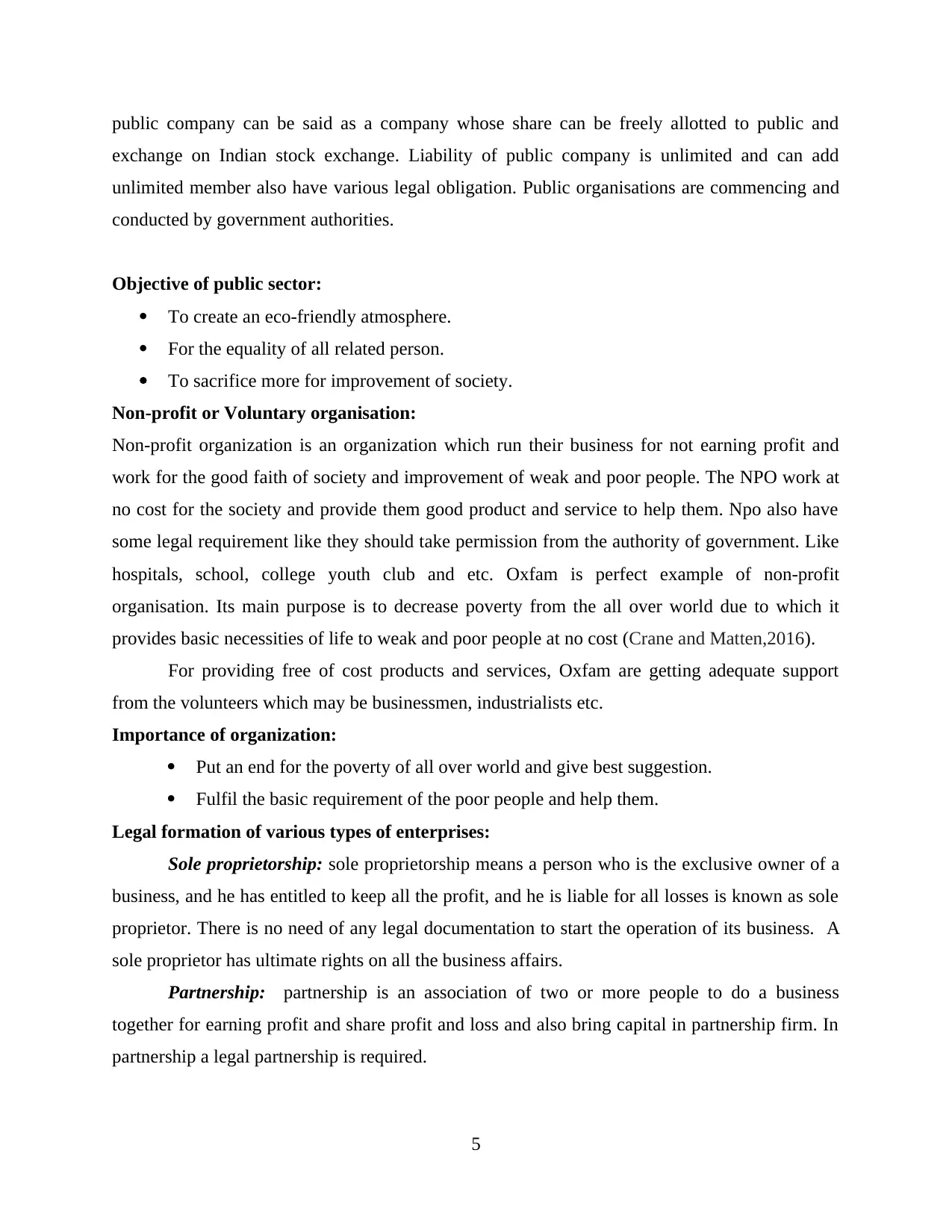
public company can be said as a company whose share can be freely allotted to public and
exchange on Indian stock exchange. Liability of public company is unlimited and can add
unlimited member also have various legal obligation. Public organisations are commencing and
conducted by government authorities.
Objective of public sector:
To create an eco-friendly atmosphere.
For the equality of all related person.
To sacrifice more for improvement of society.
Non-profit or Voluntary organisation:
Non-profit organization is an organization which run their business for not earning profit and
work for the good faith of society and improvement of weak and poor people. The NPO work at
no cost for the society and provide them good product and service to help them. Npo also have
some legal requirement like they should take permission from the authority of government. Like
hospitals, school, college youth club and etc. Oxfam is perfect example of non-profit
organisation. Its main purpose is to decrease poverty from the all over world due to which it
provides basic necessities of life to weak and poor people at no cost (Crane and Matten,2016).
For providing free of cost products and services, Oxfam are getting adequate support
from the volunteers which may be businessmen, industrialists etc.
Importance of organization:
Put an end for the poverty of all over world and give best suggestion.
Fulfil the basic requirement of the poor people and help them.
Legal formation of various types of enterprises:
Sole proprietorship: sole proprietorship means a person who is the exclusive owner of a
business, and he has entitled to keep all the profit, and he is liable for all losses is known as sole
proprietor. There is no need of any legal documentation to start the operation of its business. A
sole proprietor has ultimate rights on all the business affairs.
Partnership: partnership is an association of two or more people to do a business
together for earning profit and share profit and loss and also bring capital in partnership firm. In
partnership a legal partnership is required.
5
exchange on Indian stock exchange. Liability of public company is unlimited and can add
unlimited member also have various legal obligation. Public organisations are commencing and
conducted by government authorities.
Objective of public sector:
To create an eco-friendly atmosphere.
For the equality of all related person.
To sacrifice more for improvement of society.
Non-profit or Voluntary organisation:
Non-profit organization is an organization which run their business for not earning profit and
work for the good faith of society and improvement of weak and poor people. The NPO work at
no cost for the society and provide them good product and service to help them. Npo also have
some legal requirement like they should take permission from the authority of government. Like
hospitals, school, college youth club and etc. Oxfam is perfect example of non-profit
organisation. Its main purpose is to decrease poverty from the all over world due to which it
provides basic necessities of life to weak and poor people at no cost (Crane and Matten,2016).
For providing free of cost products and services, Oxfam are getting adequate support
from the volunteers which may be businessmen, industrialists etc.
Importance of organization:
Put an end for the poverty of all over world and give best suggestion.
Fulfil the basic requirement of the poor people and help them.
Legal formation of various types of enterprises:
Sole proprietorship: sole proprietorship means a person who is the exclusive owner of a
business, and he has entitled to keep all the profit, and he is liable for all losses is known as sole
proprietor. There is no need of any legal documentation to start the operation of its business. A
sole proprietor has ultimate rights on all the business affairs.
Partnership: partnership is an association of two or more people to do a business
together for earning profit and share profit and loss and also bring capital in partnership firm. In
partnership a legal partnership is required.
5
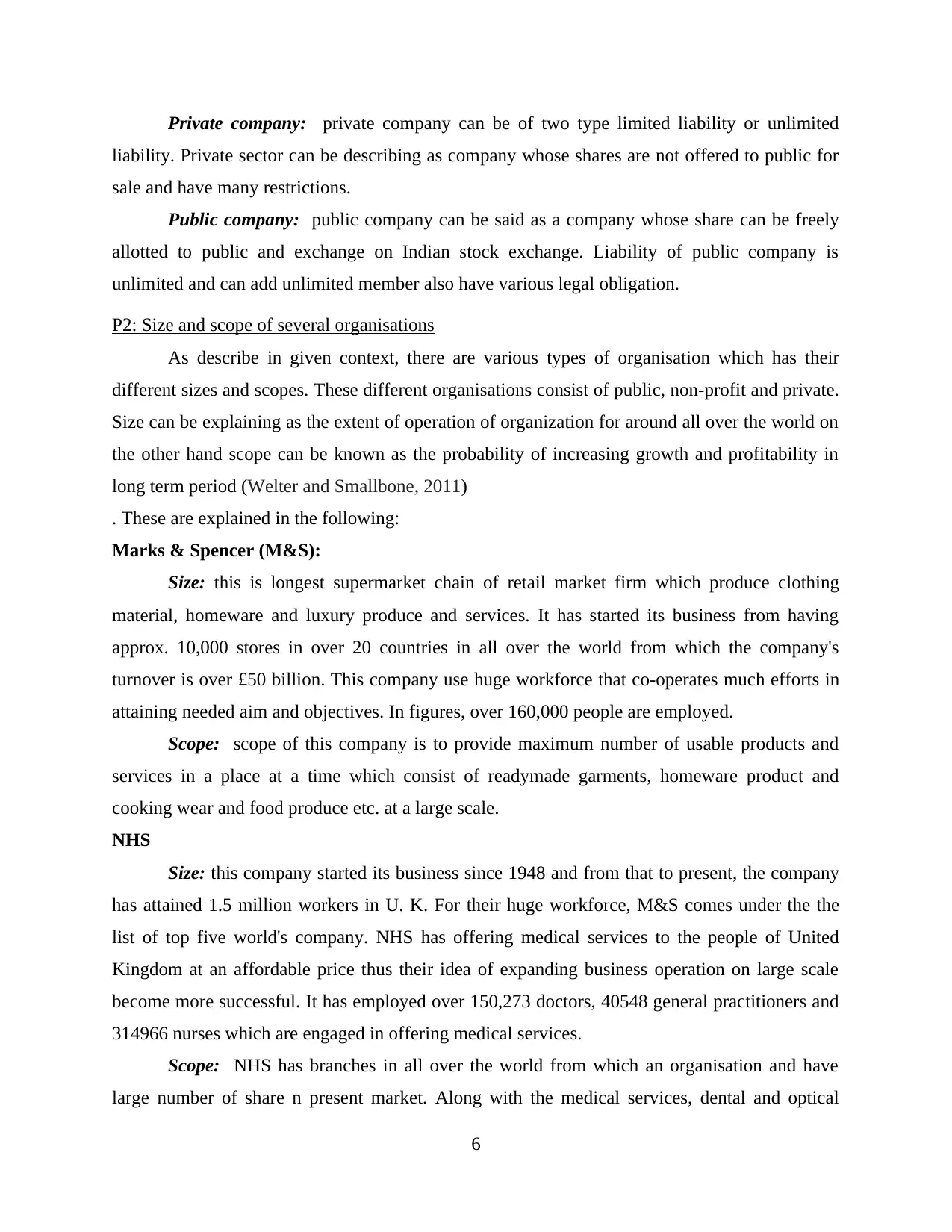
Private company: private company can be of two type limited liability or unlimited
liability. Private sector can be describing as company whose shares are not offered to public for
sale and have many restrictions.
Public company: public company can be said as a company whose share can be freely
allotted to public and exchange on Indian stock exchange. Liability of public company is
unlimited and can add unlimited member also have various legal obligation.
P2: Size and scope of several organisations
As describe in given context, there are various types of organisation which has their
different sizes and scopes. These different organisations consist of public, non-profit and private.
Size can be explaining as the extent of operation of organization for around all over the world on
the other hand scope can be known as the probability of increasing growth and profitability in
long term period (Welter and Smallbone, 2011)
. These are explained in the following:
Marks & Spencer (M&S):
Size: this is longest supermarket chain of retail market firm which produce clothing
material, homeware and luxury produce and services. It has started its business from having
approx. 10,000 stores in over 20 countries in all over the world from which the company's
turnover is over £50 billion. This company use huge workforce that co-operates much efforts in
attaining needed aim and objectives. In figures, over 160,000 people are employed.
Scope: scope of this company is to provide maximum number of usable products and
services in a place at a time which consist of readymade garments, homeware product and
cooking wear and food produce etc. at a large scale.
NHS
Size: this company started its business since 1948 and from that to present, the company
has attained 1.5 million workers in U. K. For their huge workforce, M&S comes under the the
list of top five world's company. NHS has offering medical services to the people of United
Kingdom at an affordable price thus their idea of expanding business operation on large scale
become more successful. It has employed over 150,273 doctors, 40548 general practitioners and
314966 nurses which are engaged in offering medical services.
Scope: NHS has branches in all over the world from which an organisation and have
large number of share n present market. Along with the medical services, dental and optical
6
liability. Private sector can be describing as company whose shares are not offered to public for
sale and have many restrictions.
Public company: public company can be said as a company whose share can be freely
allotted to public and exchange on Indian stock exchange. Liability of public company is
unlimited and can add unlimited member also have various legal obligation.
P2: Size and scope of several organisations
As describe in given context, there are various types of organisation which has their
different sizes and scopes. These different organisations consist of public, non-profit and private.
Size can be explaining as the extent of operation of organization for around all over the world on
the other hand scope can be known as the probability of increasing growth and profitability in
long term period (Welter and Smallbone, 2011)
. These are explained in the following:
Marks & Spencer (M&S):
Size: this is longest supermarket chain of retail market firm which produce clothing
material, homeware and luxury produce and services. It has started its business from having
approx. 10,000 stores in over 20 countries in all over the world from which the company's
turnover is over £50 billion. This company use huge workforce that co-operates much efforts in
attaining needed aim and objectives. In figures, over 160,000 people are employed.
Scope: scope of this company is to provide maximum number of usable products and
services in a place at a time which consist of readymade garments, homeware product and
cooking wear and food produce etc. at a large scale.
NHS
Size: this company started its business since 1948 and from that to present, the company
has attained 1.5 million workers in U. K. For their huge workforce, M&S comes under the the
list of top five world's company. NHS has offering medical services to the people of United
Kingdom at an affordable price thus their idea of expanding business operation on large scale
become more successful. It has employed over 150,273 doctors, 40548 general practitioners and
314966 nurses which are engaged in offering medical services.
Scope: NHS has branches in all over the world from which an organisation and have
large number of share n present market. Along with the medical services, dental and optical
6
⊘ This is a preview!⊘
Do you want full access?
Subscribe today to unlock all pages.

Trusted by 1+ million students worldwide
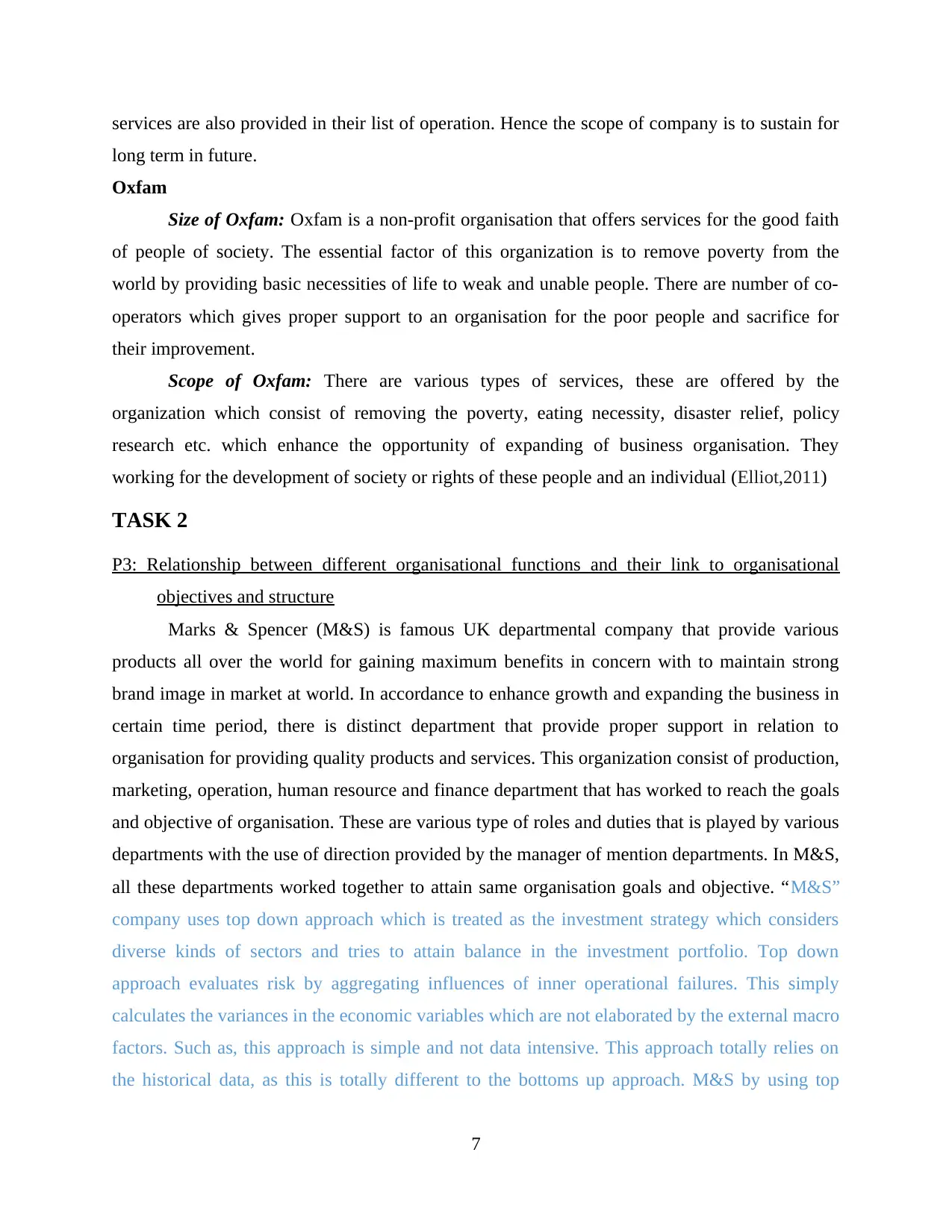
services are also provided in their list of operation. Hence the scope of company is to sustain for
long term in future.
Oxfam
Size of Oxfam: Oxfam is a non-profit organisation that offers services for the good faith
of people of society. The essential factor of this organization is to remove poverty from the
world by providing basic necessities of life to weak and unable people. There are number of co-
operators which gives proper support to an organisation for the poor people and sacrifice for
their improvement.
Scope of Oxfam: There are various types of services, these are offered by the
organization which consist of removing the poverty, eating necessity, disaster relief, policy
research etc. which enhance the opportunity of expanding of business organisation. They
working for the development of society or rights of these people and an individual (Elliot,2011)
TASK 2
P3: Relationship between different organisational functions and their link to organisational
objectives and structure
Marks & Spencer (M&S) is famous UK departmental company that provide various
products all over the world for gaining maximum benefits in concern with to maintain strong
brand image in market at world. In accordance to enhance growth and expanding the business in
certain time period, there is distinct department that provide proper support in relation to
organisation for providing quality products and services. This organization consist of production,
marketing, operation, human resource and finance department that has worked to reach the goals
and objective of organisation. These are various type of roles and duties that is played by various
departments with the use of direction provided by the manager of mention departments. In M&S,
all these departments worked together to attain same organisation goals and objective. “M&S”
company uses top down approach which is treated as the investment strategy which considers
diverse kinds of sectors and tries to attain balance in the investment portfolio. Top down
approach evaluates risk by aggregating influences of inner operational failures. This simply
calculates the variances in the economic variables which are not elaborated by the external macro
factors. Such as, this approach is simple and not data intensive. This approach totally relies on
the historical data, as this is totally different to the bottoms up approach. M&S by using top
7
long term in future.
Oxfam
Size of Oxfam: Oxfam is a non-profit organisation that offers services for the good faith
of people of society. The essential factor of this organization is to remove poverty from the
world by providing basic necessities of life to weak and unable people. There are number of co-
operators which gives proper support to an organisation for the poor people and sacrifice for
their improvement.
Scope of Oxfam: There are various types of services, these are offered by the
organization which consist of removing the poverty, eating necessity, disaster relief, policy
research etc. which enhance the opportunity of expanding of business organisation. They
working for the development of society or rights of these people and an individual (Elliot,2011)
TASK 2
P3: Relationship between different organisational functions and their link to organisational
objectives and structure
Marks & Spencer (M&S) is famous UK departmental company that provide various
products all over the world for gaining maximum benefits in concern with to maintain strong
brand image in market at world. In accordance to enhance growth and expanding the business in
certain time period, there is distinct department that provide proper support in relation to
organisation for providing quality products and services. This organization consist of production,
marketing, operation, human resource and finance department that has worked to reach the goals
and objective of organisation. These are various type of roles and duties that is played by various
departments with the use of direction provided by the manager of mention departments. In M&S,
all these departments worked together to attain same organisation goals and objective. “M&S”
company uses top down approach which is treated as the investment strategy which considers
diverse kinds of sectors and tries to attain balance in the investment portfolio. Top down
approach evaluates risk by aggregating influences of inner operational failures. This simply
calculates the variances in the economic variables which are not elaborated by the external macro
factors. Such as, this approach is simple and not data intensive. This approach totally relies on
the historical data, as this is totally different to the bottoms up approach. M&S by using top
7
Paraphrase This Document
Need a fresh take? Get an instant paraphrase of this document with our AI Paraphraser
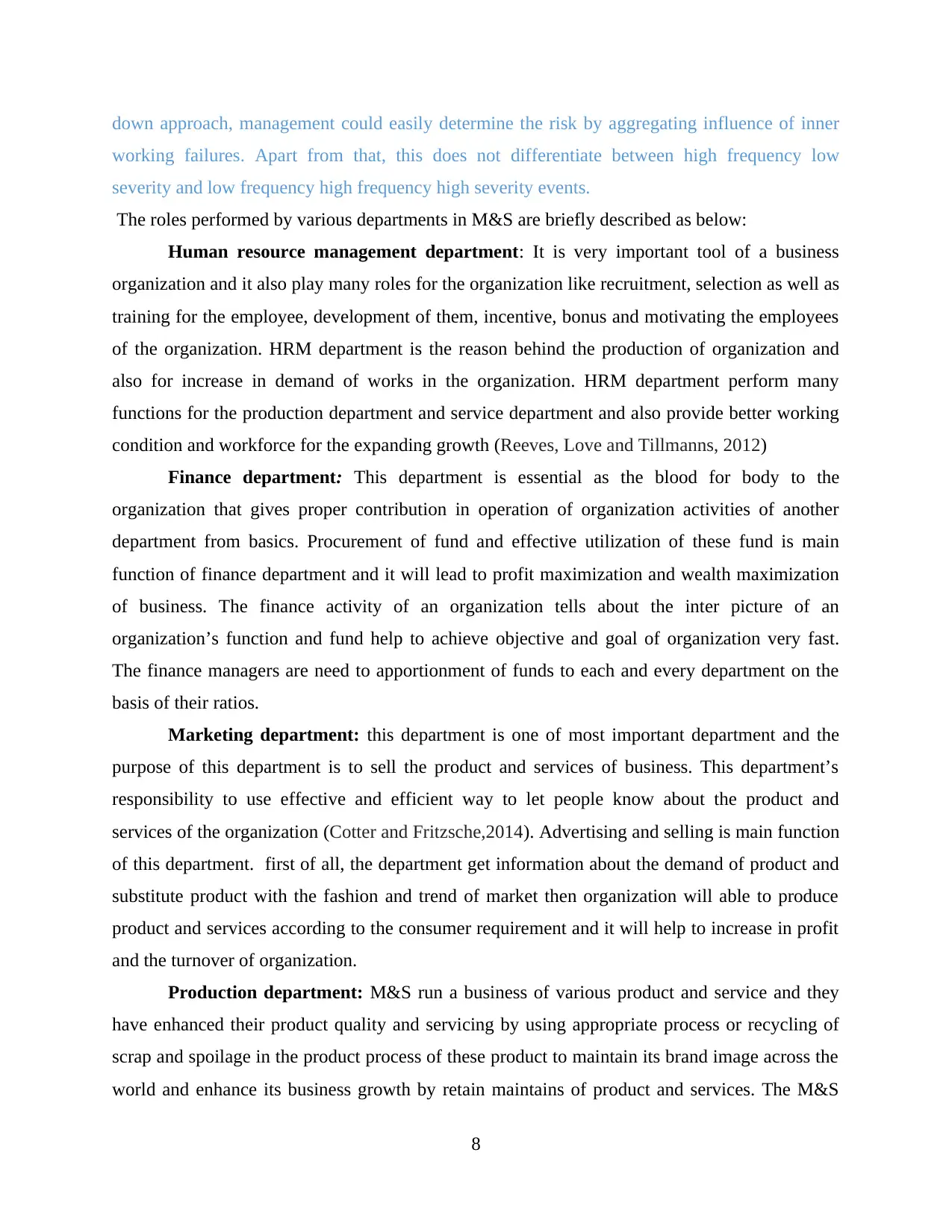
down approach, management could easily determine the risk by aggregating influence of inner
working failures. Apart from that, this does not differentiate between high frequency low
severity and low frequency high frequency high severity events.
The roles performed by various departments in M&S are briefly described as below:
Human resource management department: It is very important tool of a business
organization and it also play many roles for the organization like recruitment, selection as well as
training for the employee, development of them, incentive, bonus and motivating the employees
of the organization. HRM department is the reason behind the production of organization and
also for increase in demand of works in the organization. HRM department perform many
functions for the production department and service department and also provide better working
condition and workforce for the expanding growth (Reeves, Love and Tillmanns, 2012)
Finance department: This department is essential as the blood for body to the
organization that gives proper contribution in operation of organization activities of another
department from basics. Procurement of fund and effective utilization of these fund is main
function of finance department and it will lead to profit maximization and wealth maximization
of business. The finance activity of an organization tells about the inter picture of an
organization’s function and fund help to achieve objective and goal of organization very fast.
The finance managers are need to apportionment of funds to each and every department on the
basis of their ratios.
Marketing department: this department is one of most important department and the
purpose of this department is to sell the product and services of business. This department’s
responsibility to use effective and efficient way to let people know about the product and
services of the organization (Cotter and Fritzsche,2014). Advertising and selling is main function
of this department. first of all, the department get information about the demand of product and
substitute product with the fashion and trend of market then organization will able to produce
product and services according to the consumer requirement and it will help to increase in profit
and the turnover of organization.
Production department: M&S run a business of various product and service and they
have enhanced their product quality and servicing by using appropriate process or recycling of
scrap and spoilage in the product process of these product to maintain its brand image across the
world and enhance its business growth by retain maintains of product and services. The M&S
8
working failures. Apart from that, this does not differentiate between high frequency low
severity and low frequency high frequency high severity events.
The roles performed by various departments in M&S are briefly described as below:
Human resource management department: It is very important tool of a business
organization and it also play many roles for the organization like recruitment, selection as well as
training for the employee, development of them, incentive, bonus and motivating the employees
of the organization. HRM department is the reason behind the production of organization and
also for increase in demand of works in the organization. HRM department perform many
functions for the production department and service department and also provide better working
condition and workforce for the expanding growth (Reeves, Love and Tillmanns, 2012)
Finance department: This department is essential as the blood for body to the
organization that gives proper contribution in operation of organization activities of another
department from basics. Procurement of fund and effective utilization of these fund is main
function of finance department and it will lead to profit maximization and wealth maximization
of business. The finance activity of an organization tells about the inter picture of an
organization’s function and fund help to achieve objective and goal of organization very fast.
The finance managers are need to apportionment of funds to each and every department on the
basis of their ratios.
Marketing department: this department is one of most important department and the
purpose of this department is to sell the product and services of business. This department’s
responsibility to use effective and efficient way to let people know about the product and
services of the organization (Cotter and Fritzsche,2014). Advertising and selling is main function
of this department. first of all, the department get information about the demand of product and
substitute product with the fashion and trend of market then organization will able to produce
product and services according to the consumer requirement and it will help to increase in profit
and the turnover of organization.
Production department: M&S run a business of various product and service and they
have enhanced their product quality and servicing by using appropriate process or recycling of
scrap and spoilage in the product process of these product to maintain its brand image across the
world and enhance its business growth by retain maintains of product and services. The M&S
8
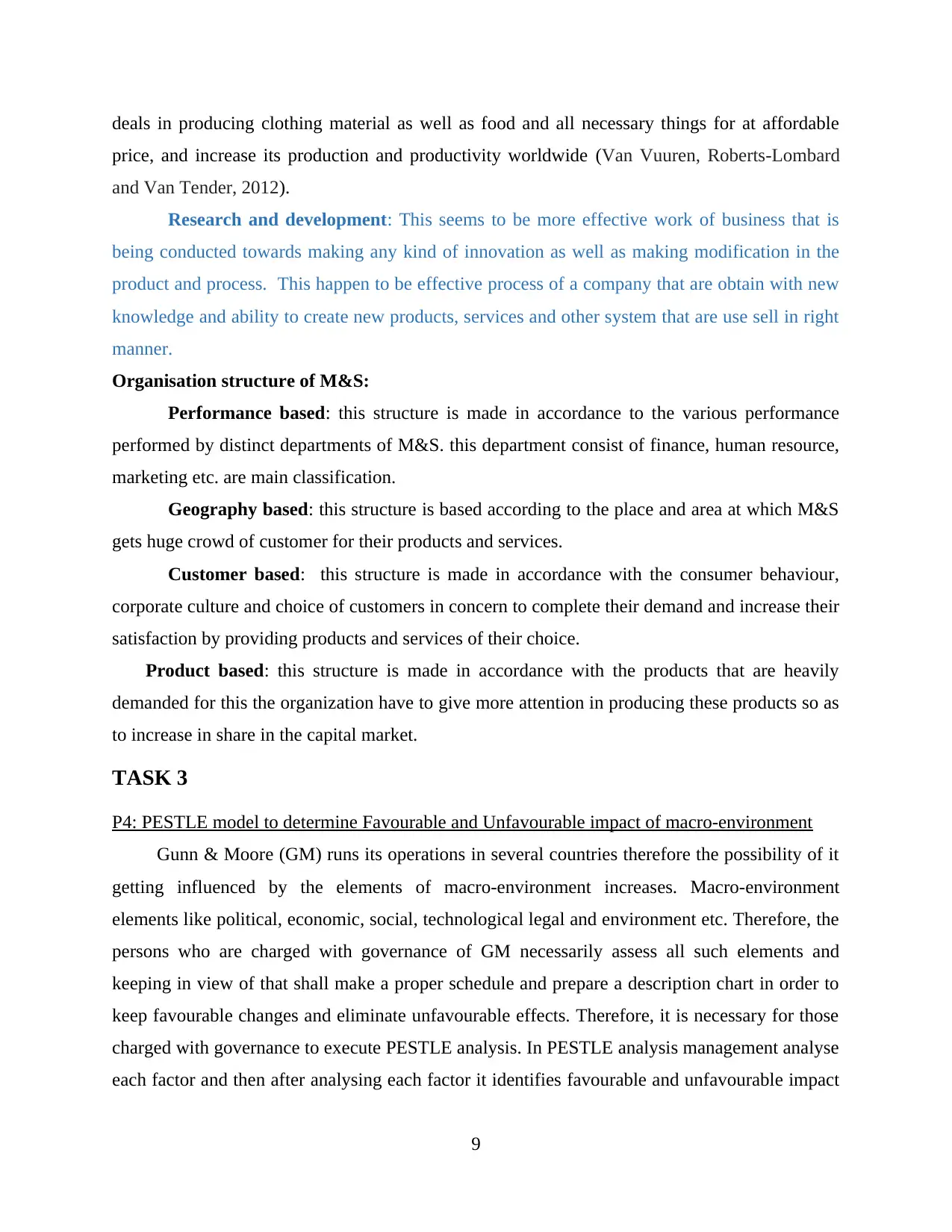
deals in producing clothing material as well as food and all necessary things for at affordable
price, and increase its production and productivity worldwide (Van Vuuren, Roberts-Lombard
and Van Tender, 2012).
Research and development: This seems to be more effective work of business that is
being conducted towards making any kind of innovation as well as making modification in the
product and process. This happen to be effective process of a company that are obtain with new
knowledge and ability to create new products, services and other system that are use sell in right
manner.
Organisation structure of M&S:
Performance based: this structure is made in accordance to the various performance
performed by distinct departments of M&S. this department consist of finance, human resource,
marketing etc. are main classification.
Geography based: this structure is based according to the place and area at which M&S
gets huge crowd of customer for their products and services.
Customer based: this structure is made in accordance with the consumer behaviour,
corporate culture and choice of customers in concern to complete their demand and increase their
satisfaction by providing products and services of their choice.
Product based: this structure is made in accordance with the products that are heavily
demanded for this the organization have to give more attention in producing these products so as
to increase in share in the capital market.
TASK 3
P4: PESTLE model to determine Favourable and Unfavourable impact of macro-environment
Gunn & Moore (GM) runs its operations in several countries therefore the possibility of it
getting influenced by the elements of macro-environment increases. Macro-environment
elements like political, economic, social, technological legal and environment etc. Therefore, the
persons who are charged with governance of GM necessarily assess all such elements and
keeping in view of that shall make a proper schedule and prepare a description chart in order to
keep favourable changes and eliminate unfavourable effects. Therefore, it is necessary for those
charged with governance to execute PESTLE analysis. In PESTLE analysis management analyse
each factor and then after analysing each factor it identifies favourable and unfavourable impact
9
price, and increase its production and productivity worldwide (Van Vuuren, Roberts-Lombard
and Van Tender, 2012).
Research and development: This seems to be more effective work of business that is
being conducted towards making any kind of innovation as well as making modification in the
product and process. This happen to be effective process of a company that are obtain with new
knowledge and ability to create new products, services and other system that are use sell in right
manner.
Organisation structure of M&S:
Performance based: this structure is made in accordance to the various performance
performed by distinct departments of M&S. this department consist of finance, human resource,
marketing etc. are main classification.
Geography based: this structure is based according to the place and area at which M&S
gets huge crowd of customer for their products and services.
Customer based: this structure is made in accordance with the consumer behaviour,
corporate culture and choice of customers in concern to complete their demand and increase their
satisfaction by providing products and services of their choice.
Product based: this structure is made in accordance with the products that are heavily
demanded for this the organization have to give more attention in producing these products so as
to increase in share in the capital market.
TASK 3
P4: PESTLE model to determine Favourable and Unfavourable impact of macro-environment
Gunn & Moore (GM) runs its operations in several countries therefore the possibility of it
getting influenced by the elements of macro-environment increases. Macro-environment
elements like political, economic, social, technological legal and environment etc. Therefore, the
persons who are charged with governance of GM necessarily assess all such elements and
keeping in view of that shall make a proper schedule and prepare a description chart in order to
keep favourable changes and eliminate unfavourable effects. Therefore, it is necessary for those
charged with governance to execute PESTLE analysis. In PESTLE analysis management analyse
each factor and then after analysing each factor it identifies favourable and unfavourable impact
9
⊘ This is a preview!⊘
Do you want full access?
Subscribe today to unlock all pages.

Trusted by 1+ million students worldwide
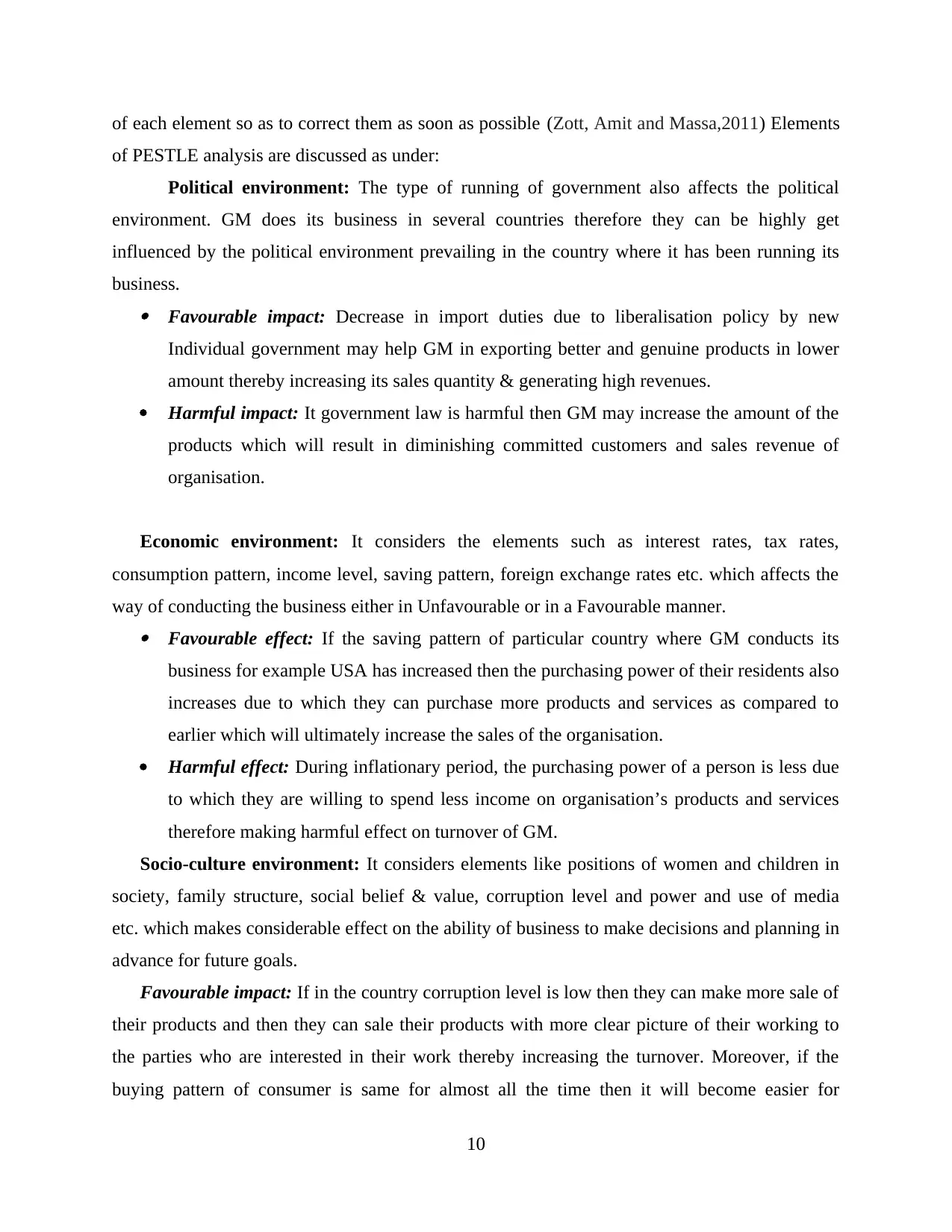
of each element so as to correct them as soon as possible (Zott, Amit and Massa,2011) Elements
of PESTLE analysis are discussed as under:
Political environment: The type of running of government also affects the political
environment. GM does its business in several countries therefore they can be highly get
influenced by the political environment prevailing in the country where it has been running its
business. Favourable impact: Decrease in import duties due to liberalisation policy by new
Individual government may help GM in exporting better and genuine products in lower
amount thereby increasing its sales quantity & generating high revenues.
Harmful impact: It government law is harmful then GM may increase the amount of the
products which will result in diminishing committed customers and sales revenue of
organisation.
Economic environment: It considers the elements such as interest rates, tax rates,
consumption pattern, income level, saving pattern, foreign exchange rates etc. which affects the
way of conducting the business either in Unfavourable or in a Favourable manner. Favourable effect: If the saving pattern of particular country where GM conducts its
business for example USA has increased then the purchasing power of their residents also
increases due to which they can purchase more products and services as compared to
earlier which will ultimately increase the sales of the organisation.
Harmful effect: During inflationary period, the purchasing power of a person is less due
to which they are willing to spend less income on organisation’s products and services
therefore making harmful effect on turnover of GM.
Socio-culture environment: It considers elements like positions of women and children in
society, family structure, social belief & value, corruption level and power and use of media
etc. which makes considerable effect on the ability of business to make decisions and planning in
advance for future goals.
Favourable impact: If in the country corruption level is low then they can make more sale of
their products and then they can sale their products with more clear picture of their working to
the parties who are interested in their work thereby increasing the turnover. Moreover, if the
buying pattern of consumer is same for almost all the time then it will become easier for
10
of PESTLE analysis are discussed as under:
Political environment: The type of running of government also affects the political
environment. GM does its business in several countries therefore they can be highly get
influenced by the political environment prevailing in the country where it has been running its
business. Favourable impact: Decrease in import duties due to liberalisation policy by new
Individual government may help GM in exporting better and genuine products in lower
amount thereby increasing its sales quantity & generating high revenues.
Harmful impact: It government law is harmful then GM may increase the amount of the
products which will result in diminishing committed customers and sales revenue of
organisation.
Economic environment: It considers the elements such as interest rates, tax rates,
consumption pattern, income level, saving pattern, foreign exchange rates etc. which affects the
way of conducting the business either in Unfavourable or in a Favourable manner. Favourable effect: If the saving pattern of particular country where GM conducts its
business for example USA has increased then the purchasing power of their residents also
increases due to which they can purchase more products and services as compared to
earlier which will ultimately increase the sales of the organisation.
Harmful effect: During inflationary period, the purchasing power of a person is less due
to which they are willing to spend less income on organisation’s products and services
therefore making harmful effect on turnover of GM.
Socio-culture environment: It considers elements like positions of women and children in
society, family structure, social belief & value, corruption level and power and use of media
etc. which makes considerable effect on the ability of business to make decisions and planning in
advance for future goals.
Favourable impact: If in the country corruption level is low then they can make more sale of
their products and then they can sale their products with more clear picture of their working to
the parties who are interested in their work thereby increasing the turnover. Moreover, if the
buying pattern of consumer is same for almost all the time then it will become easier for
10
Paraphrase This Document
Need a fresh take? Get an instant paraphrase of this document with our AI Paraphraser
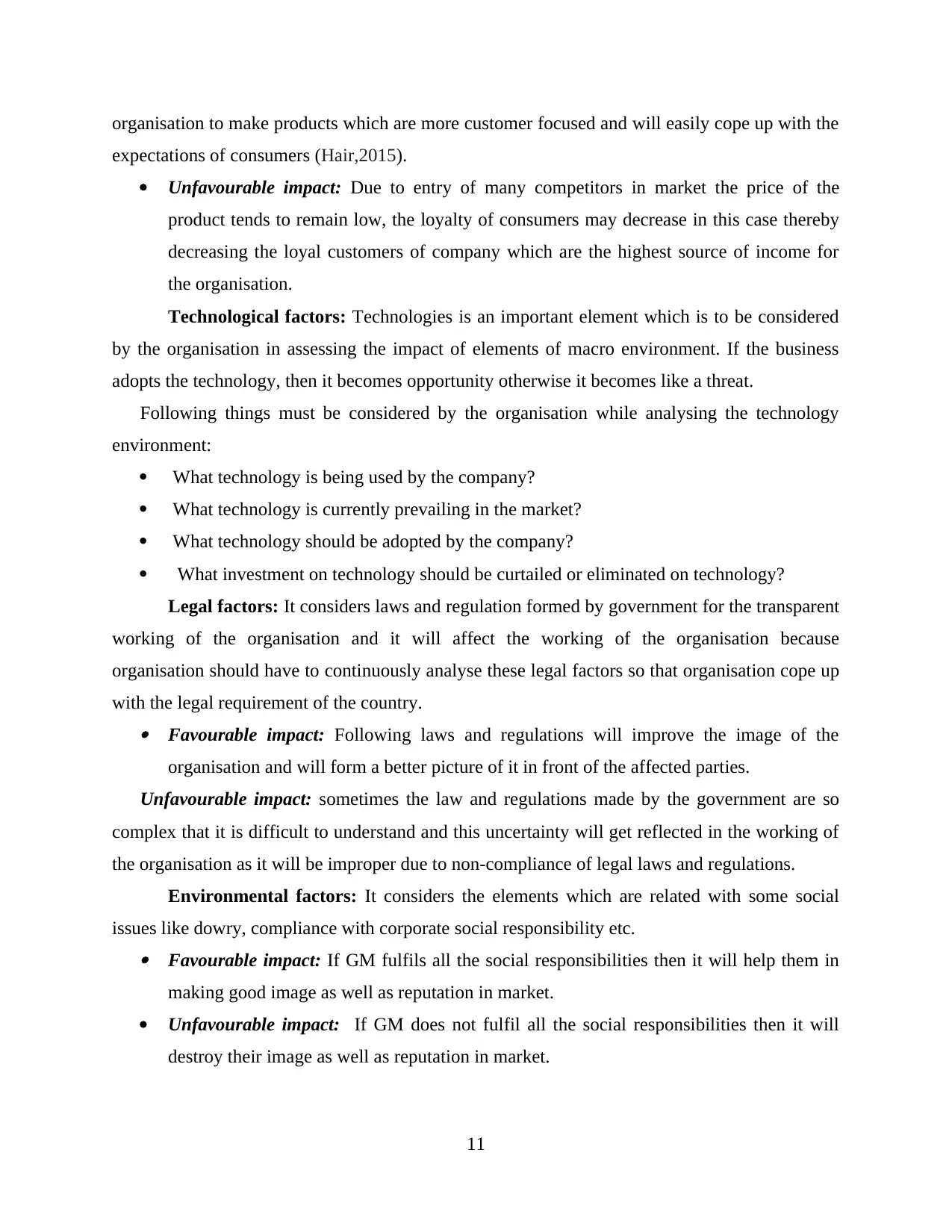
organisation to make products which are more customer focused and will easily cope up with the
expectations of consumers (Hair,2015).
Unfavourable impact: Due to entry of many competitors in market the price of the
product tends to remain low, the loyalty of consumers may decrease in this case thereby
decreasing the loyal customers of company which are the highest source of income for
the organisation.
Technological factors: Technologies is an important element which is to be considered
by the organisation in assessing the impact of elements of macro environment. If the business
adopts the technology, then it becomes opportunity otherwise it becomes like a threat.
Following things must be considered by the organisation while analysing the technology
environment:
What technology is being used by the company?
What technology is currently prevailing in the market?
What technology should be adopted by the company?
What investment on technology should be curtailed or eliminated on technology?
Legal factors: It considers laws and regulation formed by government for the transparent
working of the organisation and it will affect the working of the organisation because
organisation should have to continuously analyse these legal factors so that organisation cope up
with the legal requirement of the country. Favourable impact: Following laws and regulations will improve the image of the
organisation and will form a better picture of it in front of the affected parties.
Unfavourable impact: sometimes the law and regulations made by the government are so
complex that it is difficult to understand and this uncertainty will get reflected in the working of
the organisation as it will be improper due to non-compliance of legal laws and regulations.
Environmental factors: It considers the elements which are related with some social
issues like dowry, compliance with corporate social responsibility etc. Favourable impact: If GM fulfils all the social responsibilities then it will help them in
making good image as well as reputation in market.
Unfavourable impact: If GM does not fulfil all the social responsibilities then it will
destroy their image as well as reputation in market.
11
expectations of consumers (Hair,2015).
Unfavourable impact: Due to entry of many competitors in market the price of the
product tends to remain low, the loyalty of consumers may decrease in this case thereby
decreasing the loyal customers of company which are the highest source of income for
the organisation.
Technological factors: Technologies is an important element which is to be considered
by the organisation in assessing the impact of elements of macro environment. If the business
adopts the technology, then it becomes opportunity otherwise it becomes like a threat.
Following things must be considered by the organisation while analysing the technology
environment:
What technology is being used by the company?
What technology is currently prevailing in the market?
What technology should be adopted by the company?
What investment on technology should be curtailed or eliminated on technology?
Legal factors: It considers laws and regulation formed by government for the transparent
working of the organisation and it will affect the working of the organisation because
organisation should have to continuously analyse these legal factors so that organisation cope up
with the legal requirement of the country. Favourable impact: Following laws and regulations will improve the image of the
organisation and will form a better picture of it in front of the affected parties.
Unfavourable impact: sometimes the law and regulations made by the government are so
complex that it is difficult to understand and this uncertainty will get reflected in the working of
the organisation as it will be improper due to non-compliance of legal laws and regulations.
Environmental factors: It considers the elements which are related with some social
issues like dowry, compliance with corporate social responsibility etc. Favourable impact: If GM fulfils all the social responsibilities then it will help them in
making good image as well as reputation in market.
Unfavourable impact: If GM does not fulfil all the social responsibilities then it will
destroy their image as well as reputation in market.
11
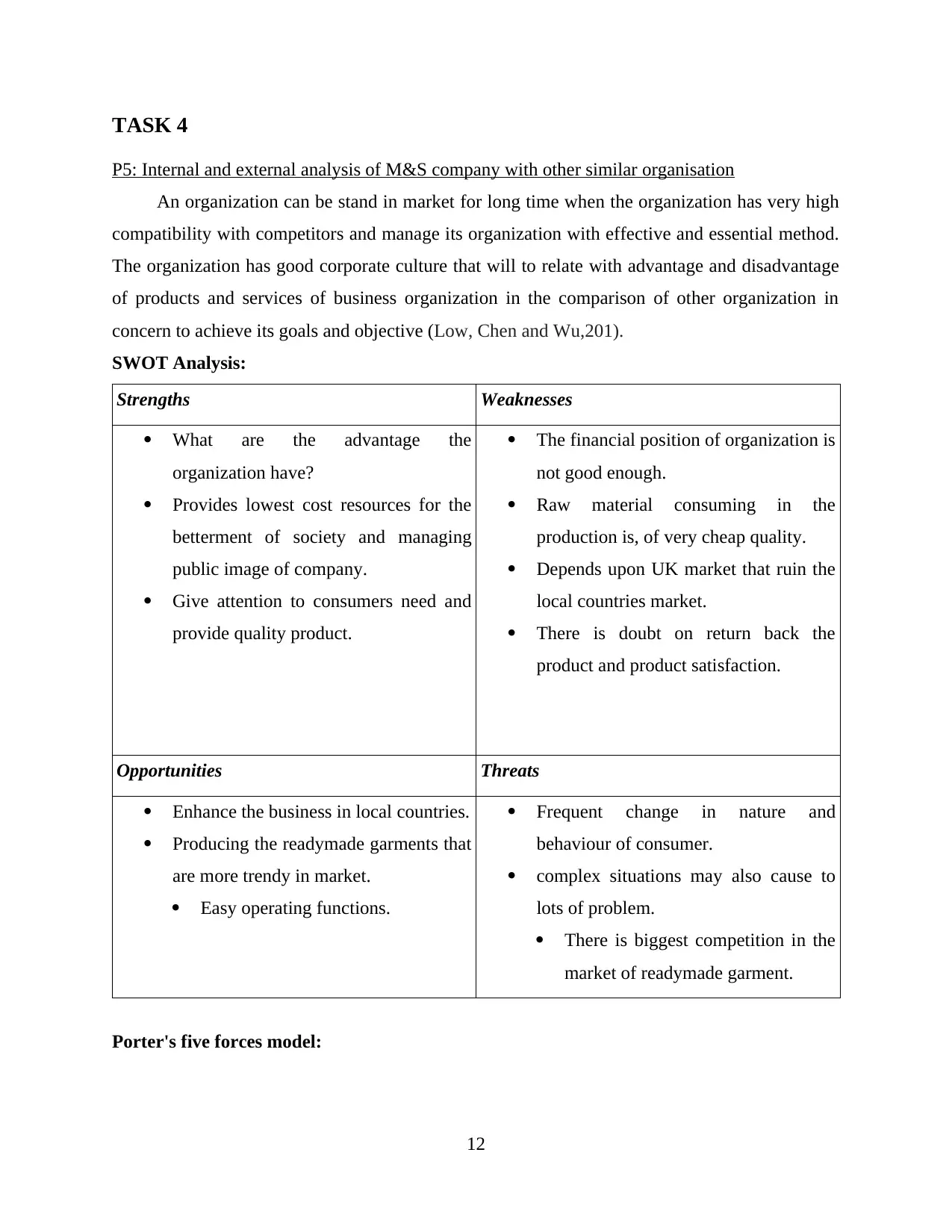
TASK 4
P5: Internal and external analysis of M&S company with other similar organisation
An organization can be stand in market for long time when the organization has very high
compatibility with competitors and manage its organization with effective and essential method.
The organization has good corporate culture that will to relate with advantage and disadvantage
of products and services of business organization in the comparison of other organization in
concern to achieve its goals and objective (Low, Chen and Wu,201).
SWOT Analysis:
Strengths Weaknesses
What are the advantage the
organization have?
Provides lowest cost resources for the
betterment of society and managing
public image of company.
Give attention to consumers need and
provide quality product.
The financial position of organization is
not good enough.
Raw material consuming in the
production is, of very cheap quality.
Depends upon UK market that ruin the
local countries market.
There is doubt on return back the
product and product satisfaction.
Opportunities Threats
Enhance the business in local countries.
Producing the readymade garments that
are more trendy in market.
Easy operating functions.
Frequent change in nature and
behaviour of consumer.
complex situations may also cause to
lots of problem.
There is biggest competition in the
market of readymade garment.
Porter's five forces model:
12
P5: Internal and external analysis of M&S company with other similar organisation
An organization can be stand in market for long time when the organization has very high
compatibility with competitors and manage its organization with effective and essential method.
The organization has good corporate culture that will to relate with advantage and disadvantage
of products and services of business organization in the comparison of other organization in
concern to achieve its goals and objective (Low, Chen and Wu,201).
SWOT Analysis:
Strengths Weaknesses
What are the advantage the
organization have?
Provides lowest cost resources for the
betterment of society and managing
public image of company.
Give attention to consumers need and
provide quality product.
The financial position of organization is
not good enough.
Raw material consuming in the
production is, of very cheap quality.
Depends upon UK market that ruin the
local countries market.
There is doubt on return back the
product and product satisfaction.
Opportunities Threats
Enhance the business in local countries.
Producing the readymade garments that
are more trendy in market.
Easy operating functions.
Frequent change in nature and
behaviour of consumer.
complex situations may also cause to
lots of problem.
There is biggest competition in the
market of readymade garment.
Porter's five forces model:
12
⊘ This is a preview!⊘
Do you want full access?
Subscribe today to unlock all pages.

Trusted by 1+ million students worldwide
1 out of 15
Related Documents
Your All-in-One AI-Powered Toolkit for Academic Success.
+13062052269
info@desklib.com
Available 24*7 on WhatsApp / Email
![[object Object]](/_next/static/media/star-bottom.7253800d.svg)
Unlock your academic potential
Copyright © 2020–2025 A2Z Services. All Rights Reserved. Developed and managed by ZUCOL.




